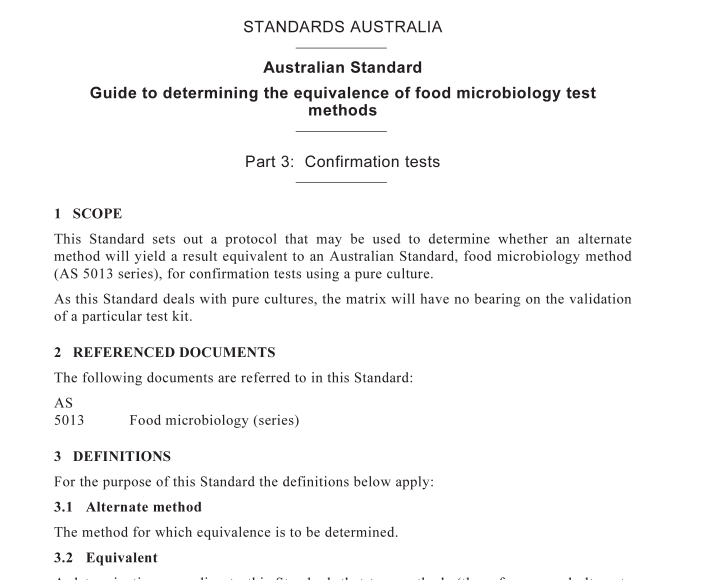AS 4659.3 pdf download – Guide to determining the equivalence of food microbiology test methods Part 3: Confirmation tests

AS 4659.3 pdf download – Guide to determining the equivalence of food microbiology test methods Part 3: Confirmation tests
1 sCOPE
This Standard sets out a protocol that may be used to determine whether an alternatemethod will yield a result equivalent to an Australian Standard,food microbiology method(AS 5013 series), for confirmation tests using a pure culture.
As this Standard deals with pure cultures, the matrix will have no bearing on the validationof a particular test kit.
2REFERENCED DOCUMENTS
The following documents are referred to in this Standard:AS
5013
Food microbiology (series)
3DEFINITIONS
For the purpose of this Standard the definitions below apply:3.1Alternate method
The method for which equivalence is to be determined.3.2 Equivalent
A determination according to this Standard,that two methods (the reference and alternatemethods) give results that are not statistically different when confirming cultures.
3.3 False negative
When the alternate method yields a negative result the reference method yields a positiveresult.
3.4 False positive
When the alternate method yields a positive result but the reference method yields anegative result.
NOTE:A ‘false positive’ may be a true positive which was not detected by the reference method.Such occurrences need to be carefully verified. For the purpose of this Standard they will beconsidered false positives because the guide is aimed at demonstrating the equivalence of the twomethods.
3.5 Reference method
The Australian Standard method against which the alternate method will be compared.3.6Target organism
The genus,species,antigenically,toxicologically or physiologically defined group oforganisms which the reference method is designed to detect.
4PROCEDURE
4.1 Define the equivalence determination
The equivalence determination should be defined in terms of the following:(a) The target organism’s genus,species, serotype, etc.
(b)The alternate method—precisely defined by reference to a publication, manufacturer’s
instructions and any optional procedures employed or deviation from the publishedmethod.
(c) The reference method——-including the specification of any optional steps.(d) The steps of the methods that are to be compared.
4.2 Define the conditions of the equivalence determination
The conditions of the equivalence determination should be defined in terms of thefollowing:
(a) The laboratory where testing is performed.
(b)Controls observed by the laboratory during testing,for example,controls on the
environment of the laboratory, prevention of cross contamination,controls on mediaand reagents, calibration of equipment, etc. where these factors are considered criticalto the success of either method.
(c)The staff performing the tests (experience,qualifications, etc.).(d)The starting and finishing dates of the tests.
(e)The batch numbers of media, reagents,etc. used.
NOTE: This information is defined for the purpose of reporting on the equivalencedetermination and recording factors which may have some bearing on the results obtained.These factors do not necessarily affect the veracity of the study.
4.3Select test organisms
Fifty strains should be selected. These are to include diversity in the strain selected.Aminimum of 20 positive isolates and 20 closely related negative isolates should be selected.In addition, a minimum of 10 non-related strains should be tested.
The reference cultures prescribed in the Australia Standard method should be included.Theother strains may be selected from the following list (in order of preference):
(a)Strains of the target organism isolated by the laboratory.
(b)Strains of the target organism isolated by reference laboratories or industry sources asrepresentative.
(c)Strains of the target organism held by culture collections.
The identity of the strains chosen should be determined by appropriate means (e.g.biochemical,physiological,serological, molecular) before performing further work.Consultation with a reference laboratory or an expert may be necessary. The source andidentity of the strains should be recorded.
NOTE: It is possible, by the selection of test strains, to bias the results of the study.Care shouldbe taken to select representative strains which do not possess characteristics which are likely tolead to biased results being obtained.









